Quality Evaluation of Atractylodis Macrocephalae Rhizoma Based on Combinative Method of HPLC Fingerprint, Quantitative Analysis of Multi-Components and Chemical Pattern Recognition Analysis
Abstract
:1. Introduction
2. Results and Discussion
2.1. Selection of Detection Wavelength
2.2. Optimization of Chromatographic Conditions
2.3. Identification of the Common Peaks
2.4. Validation of the HPLC Fingerprint Method
2.5. Chemical Pattern Recognition Analysis
2.5.1. Systematic Cluster Analysis
2.5.2. Principal Component Analysis (PCA)
2.5.3. Partial Least-Squares Discriminant Analysis (PLS-DA)
2.6. Validation of the HPLC Quantification Method
2.7. Quantification of the Samples of AMR
2.8. Limit Setting
3. Materials and Methods
3.1. Chemicals and Reagents
3.2. Screen of the Chromatographic Elution Program
3.3. System Suitability Test of HPLC Fingerprint
3.4. System Suitability Test of HPLC Quantification
3.5. Establishment of the HPLC Chromatogram of AMR
3.6. Validation of the HPLC Fingerprint Method
3.7. Validation of the HPLC Quantification Method
3.8. Statistical Analysis
4. Conclusions
Supplementary Materials
Author Contributions
Funding
Institutional Review Board Statement
Informed Consent Statement
Data Availability Statement
Acknowledgments
Conflicts of Interest
Sample Availability
References
- The pharmacopoeia committee of People’s Republic of China. Pharmacopeia of Pharmacopeia of People’s Republic of China, 11st ed.; China Medical Science Press: Beijing, China, 2020; Volume I, p. 107. [Google Scholar]
- Yao, C.M.; Yang, X.W. Bioactivity-guided isolation of polyacetylenes with inhibitory activity against NO production in LPS-activated RAW264.7 macrophages from the rhizomes of Atractylodes macrocephala. J. Ethnopharmacol. 2014, 151, 791–799. [Google Scholar] [CrossRef] [PubMed]
- Huang, H.L.; Lin, T.W.; Huang, Y.L.; Huang, R.L. Induction of apoptosis and differentiation by atractylenolide-1 isolated from Atractylodes macrocephala in human leukemia cells. Bioorg. Med. Chem. Lett. 2016, 26, 1905–1909. [Google Scholar] [CrossRef] [PubMed]
- Liu, H.Y.; Zhu, Y.J.; Zhang, T.; Zhao, Z.G.; Zhao, Y.; Cheng, P.; Li, H.; Gao, H.; Su, X.M. Anti-tumor effects of atractylenolide I isolated from Atractylodes macrocephala in human lung carcinoma cell lines. Molecules 2013, 18, 13357–13368. [Google Scholar] [CrossRef] [PubMed] [Green Version]
- Zhang, N.; Liu, C.; Sun, T.M.; Ran, X.K.; Kang, T.G.; Dou, D.Q. Two new compounds from Atractylodes macrocephala with neuroprotective activity. J. Asian Nat. Prod. Res. 2017, 19, 35–41. [Google Scholar] [CrossRef] [PubMed]
- Han, J.H.; Kim, J.H.; Kim, S.G.; Jung, S.H.; Kim, D.H.; Kim, G.E.; Whang, W.K. Anti-oxidative compounds from the aerial parts of Atractylodes macrocephala Koidzumi. Yakhak Hoechi 2007, 51, 88–95. [Google Scholar]
- Li, X.C.; Lin, J.; Han, W.J.; Mai, W.Q.; Wang, L.; Li, Q.; Lin, M.F.; Bai, M.S.; Zhang, L.S.; Chen, D.F. Antioxidant ability and mechanism of rhizoma Atractylodes macrocephala. Molecules 2012, 17, 13457–13472. [Google Scholar] [CrossRef] [PubMed] [Green Version]
- Han, K.H.; Park, J.M.; Jeong, M. Heme oxygenase-1 induction and anti-inflammatory actions of Atractylodes macrocephala and Taraxacum herba extracts prevented colitis and was more effective than sulfasalazine in preventing relapse. Gut Liver 2017, 11, 655–666. [Google Scholar] [CrossRef] [PubMed] [Green Version]
- Hoang, L.S.; Tran, M.H.; Lee, J.S.; Ngo, Q.M.T.; Woo, M.H.; Min, B.S. Inflammatory inhibitory activity of sesquiterpenoids from Atractylodes macrocephala rhizomes. Chem. Pharm. Bull. 2016, 64, 507–511. [Google Scholar] [CrossRef] [PubMed] [Green Version]
- Dong, H.Y.; He, L.L.; Huang, M.; Dong, Y.L. Anti-inflammatory components isolated from Atractylodes macrocephala Koidz. Nat. Prod. Res. 2008, 22, 1418–1427. [Google Scholar] [CrossRef] [PubMed]
- Chen, Z.L.; Cao, W.Y.; Zhou, G.X.; Wichtl, M. A sesquiterpene lactam from Artractylodes macrocephala. Phytochemistry 1997, 45, 765–767. [Google Scholar] [CrossRef]
- Ding, X.Y.; Liu, M.Y.; Chang, W.L.; Lin, H.Q. New sesquiterpenoids from the rhizomes of Atractylodes macrocephala. Chin. Pharm. J. (Taipei Taiwan) 2005, 57, 37–42. [Google Scholar]
- Zhang, Q.F.; Luo, S.D.; Wang, H.Y. Two new sesquiterpenes from Atractylodes macrocephala. Chin. Chem. Lett. 1998, 9, 1097–1100. [Google Scholar]
- Lin, Y.C.; Jin, T.; Wu, X.Y.; Huang, Z.; Fan, J.; Chan, W.L. A novel bisesquiterpenoid, biatractylolide, from the Chinese herbal plant Atractylodes macrocephala. J. Nat. Prod. 1997, 60, 27–28. [Google Scholar] [CrossRef]
- Li, Y.; Yang, X.W. New eudesmane-type sesquiterpenoids from the processed rhizomes of Atractylodes macrocephala. J Asian Nat. Prod. Res. 2014, 16, 123–128. [Google Scholar] [CrossRef] [PubMed]
- Wang, S.Y.; Ding, L.F.; Su, J.; Peng, L.Y.; Song, L.D.; Wu, X.D. Atractylmacrols A-E, sesquiterpenes from the rhizomes of Atractylodes macrocephala. Phytochem. Lett 2018, 23, 127–131. [Google Scholar] [CrossRef]
- Du, J.; Zhong, L.M.; Li, J.P.; Gong, N.C.; Peng, Y.M. Quality assessment of Atractylodes macrocephala from different producing areas. Hunan J. Trad. Chin. Med. 2020, 36, 151–154. [Google Scholar]
- Chen, Q.H.; Li, P.; He, J.; Zhu, J.; Chen, S.Y. Study on the Fingerprint of Processed Rhizoma Atractylodis Macrocephalae by HPLC. J. Chin. Med. Mater. 2009, 32, 35–38. [Google Scholar]
- Li, F.; Wu, H.Y.; Wu, G.T.; Li, Q. Study on Multi-index Quality Evaluation of Atracylodis Macrocephalae Rhizoma Based on PCA Model. Chin. J. Inf. Trad. Chin. Med. 2016, 23, 005–5304. [Google Scholar]
- Ding, Y.X.; Xu, J.X.; Wu, W.; Lu, J.M.; Dong, S.H.; Yu, J.Y.; Qing, L.P.; Zhu, B. Determination of four sesquiterpenes in Atractylodes macrocephala by HPLC. Chin. Tradit. Pat. Med. 2020, 42, 927–931. [Google Scholar]
- Yang, J.; Lin, Q.; LI, L.H.; Meng, M.; Fang, C.W. Content of Atractylenolides in Atractylodes macrocephala Koidz. from She County and Other Places: A Comparative Study. J. Anhui Trad. Chin. Med Coll. 2014, 33, 75–78. [Google Scholar]
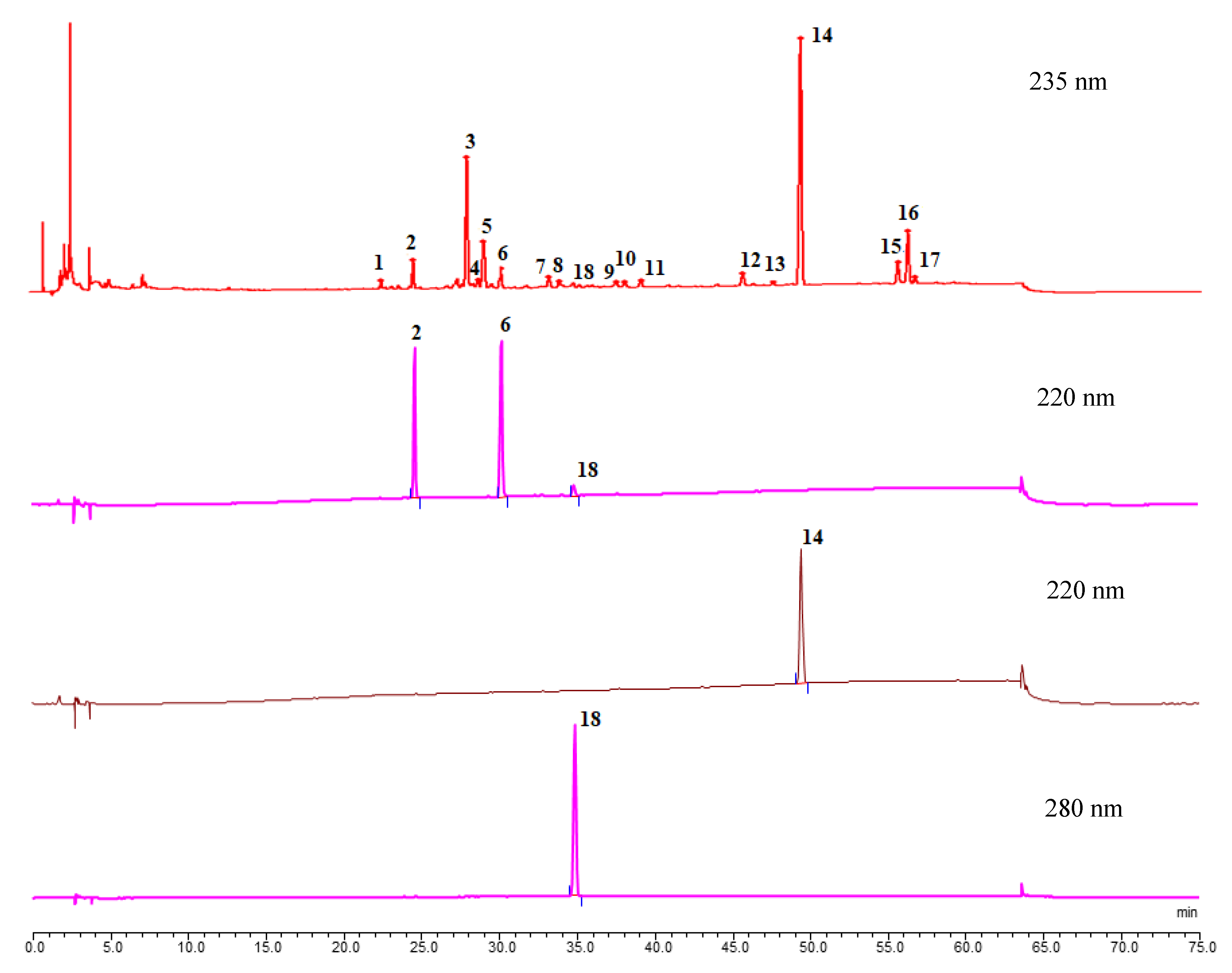

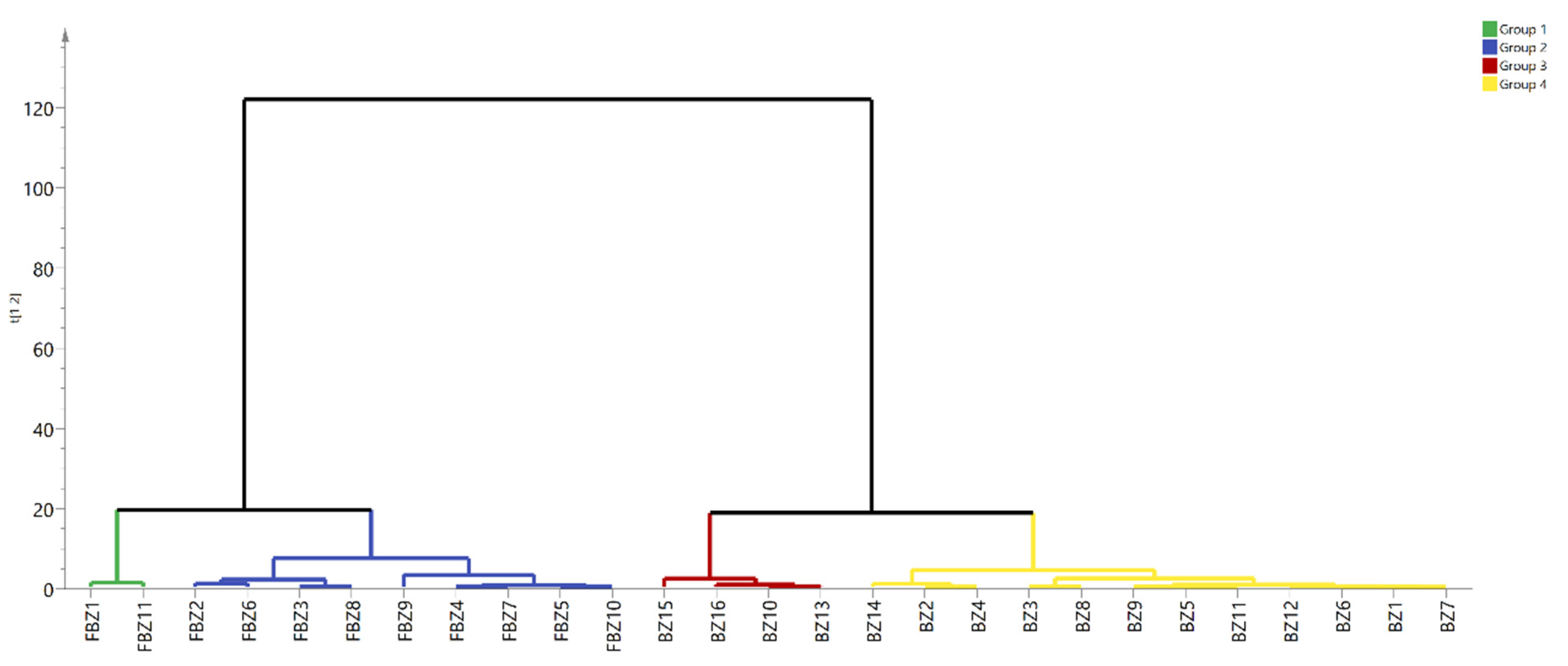

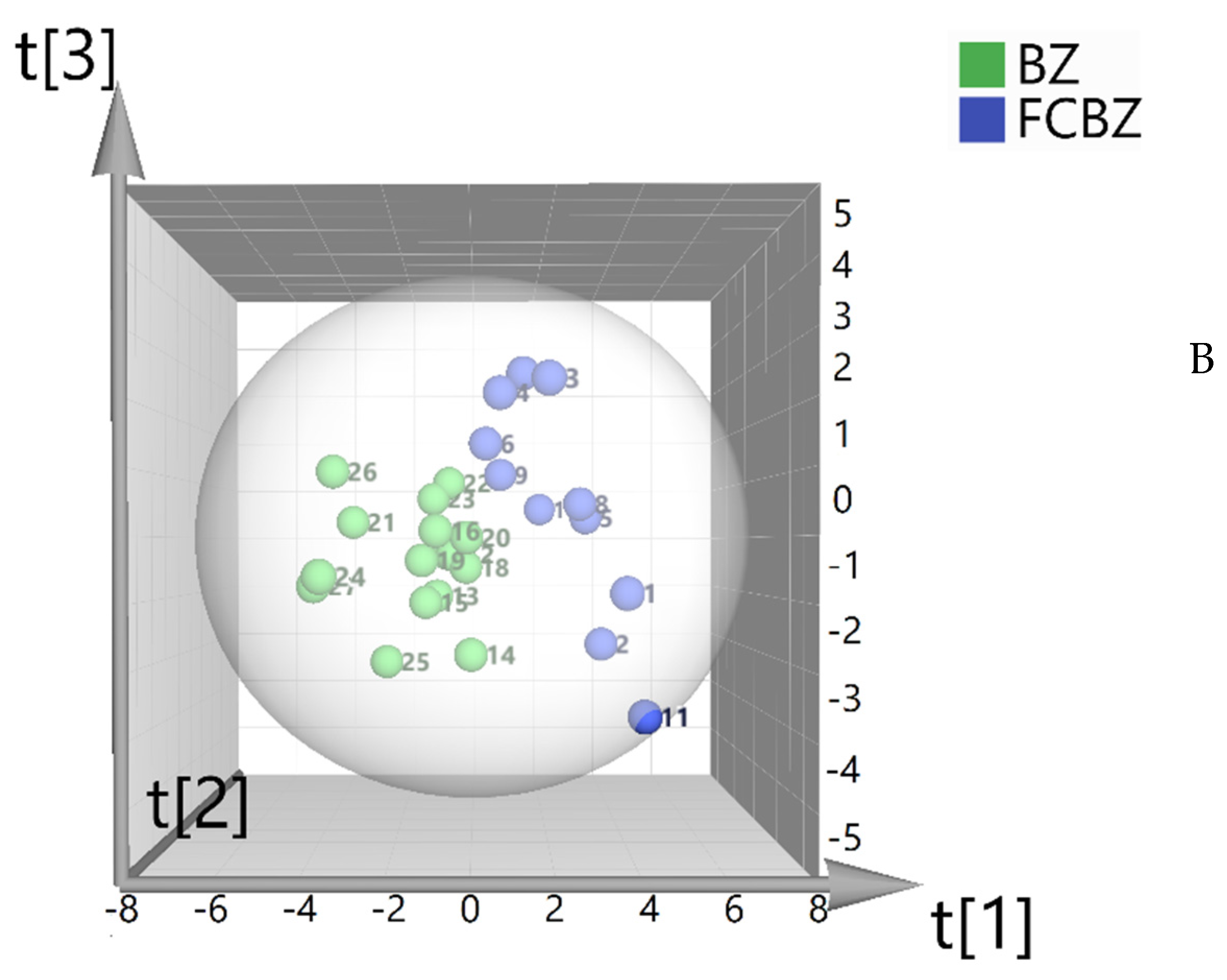
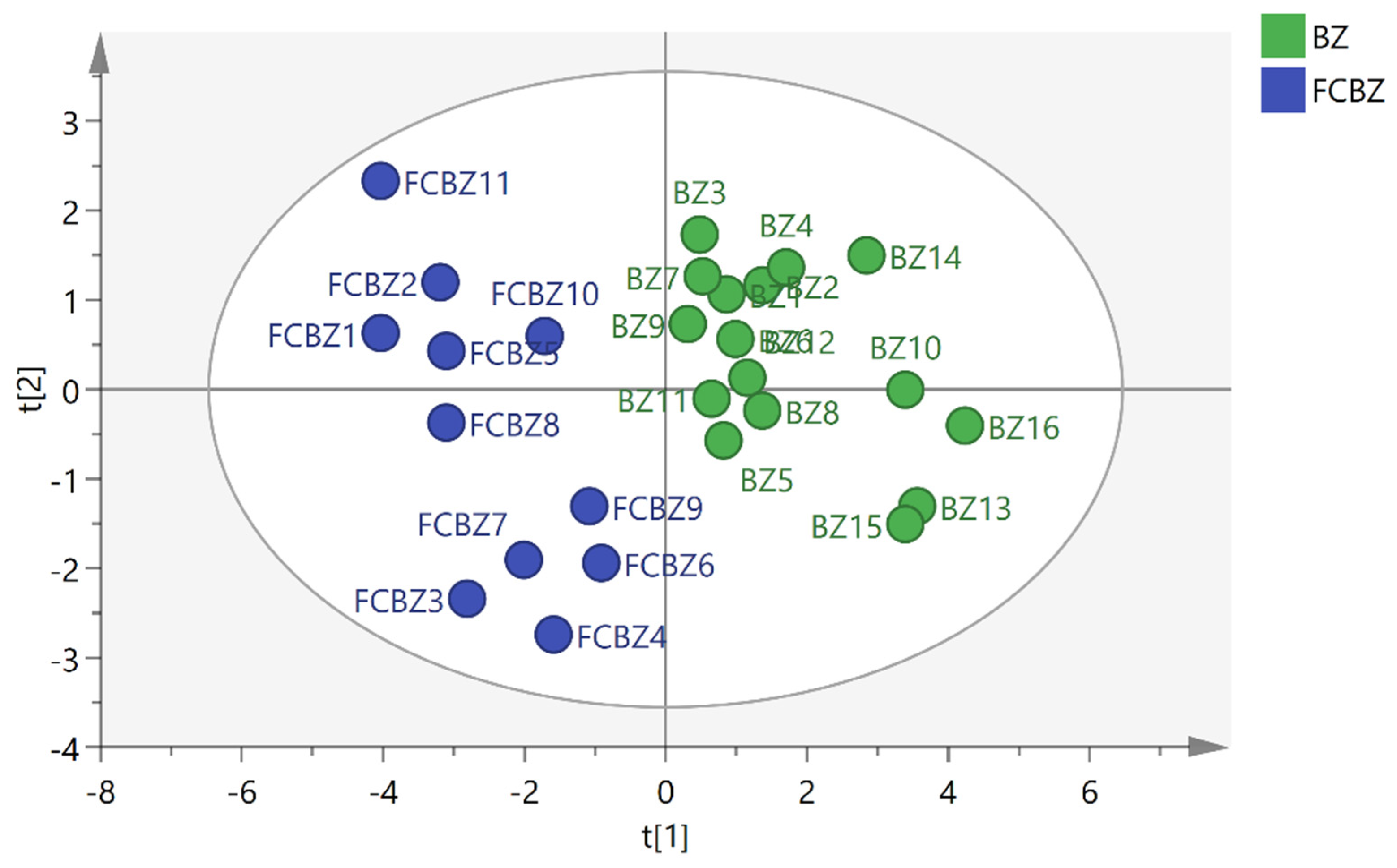

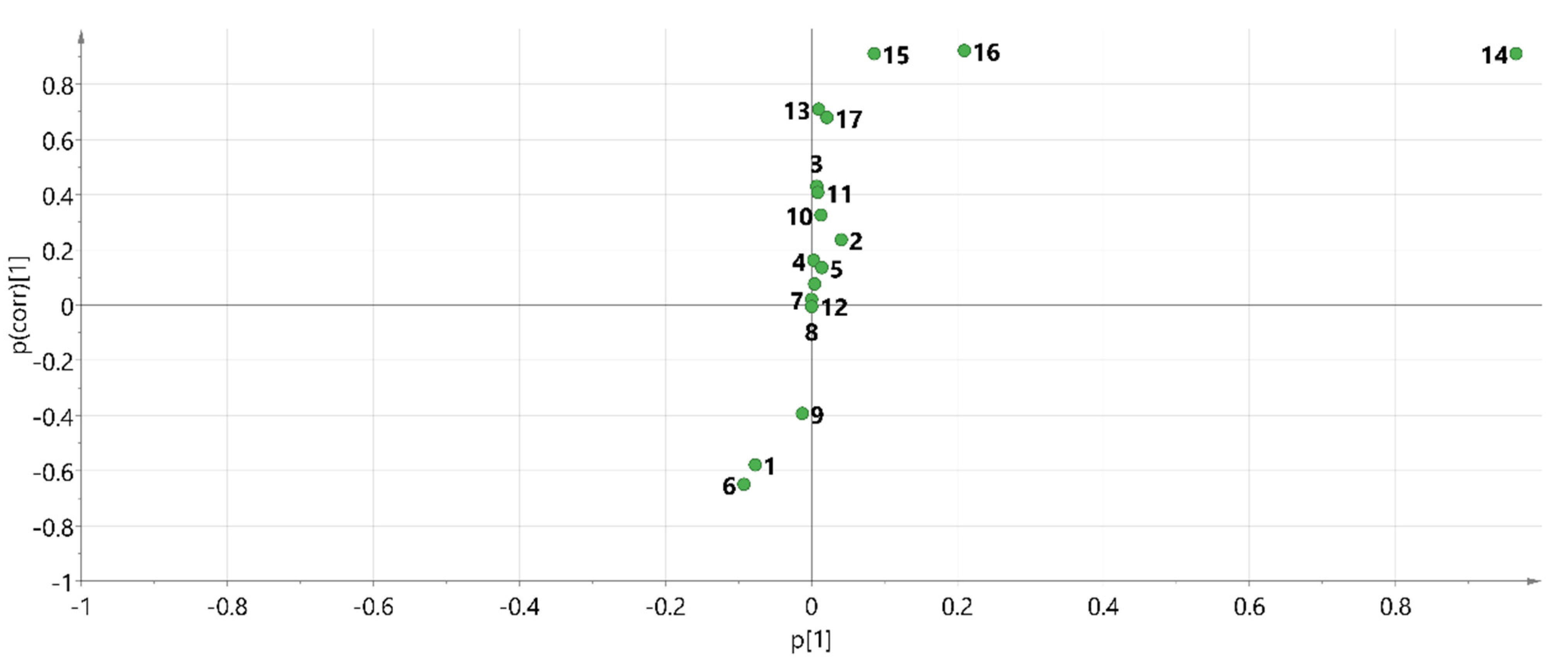
| Peak No. | Precision | Repeatability | Stability | |||||||||
|---|---|---|---|---|---|---|---|---|---|---|---|---|
| RRT | RSD (%) | RPA | RSD (%) | RRT | RSD (%) | RPA | RSD (%) | RRT | RSD (%) | RPA | RSD (%) | |
| 1 | 0.455 | 0.41% | 0.020 | 0.89% | 0.456 | 0.52% | 0.020 | 1.93% | 0.457 | 1.32% | 0.020 | 2.40% |
| 2 | 0.498 | 0.26% | 0.198 | 0.92% | 0.498 | 0.43% | 0.198 | 1.98% | 0.498 | 1.12% | 0.198 | 1.73% |
| 3 | 0.568 | 0.31% | 0.428 | 1.09% | 0.567 | 0.44% | 0.428 | 2.04% | 0.568 | 1.43% | 0.424 | 1.35% |
| 4 | 0.589 | 0.40% | 0.171 | 1.04% | 0.582 | 0.19% | 0.171 | 2.15% | 0.590 | 1.34% | 0.171 | 2.30% |
| 5 | 0.598 | 0.78% | 0.044 | 1.02% | 0.589 | 0.22% | 0.044 | 2.15% | 0.600 | 1.20% | 0.041 | 1.94% |
| 6 | 0.613 | 0.62% | 0.174 | 0.89% | 0.611 | 0.19% | 0.174 | 1.88% | 0.612 | 1.12% | 0.173 | 1.73% |
| 7 | 0.675 | 0.33% | 0.059 | 1.18% | 0.674 | 0.21% | 0.059 | 1.92% | 0.674 | 1.70% | 0.060 | 1.58% |
| 8 | 0.686 | 0.39% | 0.035 | 1.03% | 0.685 | 0.85% | 0.035 | 1.95% | 0.688 | 1.23% | 0.036 | 2.07% |
| 9 | 0.762 | 0.25% | 0.027 | 1.04% | 0.761 | 0.25% | 0.027 | 2.07% | 0.761 | 1.60% | 0.027 | 1.56% |
| 10 | 0.773 | 0.29% | 0.034 | 1.22% | 0.772 | 0.20% | 0.034 | 1.88% | 0.772 | 1.07% | 0.033 | 0.74% |
| 11 | 0.793 | 0.24% | 0.025 | 1.14% | 0.793 | 0.23% | 0.025 | 1.96% | 0.793 | 1.62% | 0.025 | 1.51% |
| 12 | 0.926 | 0.24% | 0.060 | 0.94% | 0.925 | 0.24% | 0.060 | 1.95% | 0.925 | 1.71% | 0.060 | 1.27% |
| 13 | 0.965 | 0.25% | 0.010 | 1.17% | 0.964 | 0.19% | 0.010 | 2.06% | 0.964 | 1.02% | 0.009 | 1.59% |
| 14 | 1.000 | 0.00% | 1.000 | 0.00% | 1.000 | 0.00% | 1.000 | 0.00% | 1.000 | 0.00% | 1.000 | 0.00% |
| 15 | 1.126 | 0.27% | 0.087 | 1.23% | 1.125 | 0.19% | 0.087 | 1.94% | 1.126 | 2.28% | 0.091 | 1.07% |
| 16 | 1.137 | 0.25% | 0.205 | 0.89% | 1.139 | 0.17% | 0.205 | 1.96% | 1.139 | 1.25% | 0.203 | 1.86% |
| 17 | 1.149 | 0.39% | 0.020 | 1.04% | 1.157 | 0.30% | 0.020 | 2.03% | 1.149 | 1.34% | 0.020 | 0.93% |
| Number | Batch Number | Origin | Chemical Pattern Recognition Analysis Number | Similarity |
|---|---|---|---|---|
| S1 | 180808 | Zhejiang | FBZ1 | 0.991 |
| S2 | 190701 | Zhejiang | FBZ2 | 0.974 |
| S3 | 19123001 | Zhejiang | FBZ3 | 0.887 |
| S4 | 200213 | - | FBZ4 | 0.977 |
| S5 | 2190921T | Zhejiang | FBZ5 | 0.980 |
| S6 | 1912045 | Zhejiang | FBZ6 | 0.983 |
| S7 | 191114 | Zhejiang | FBZ7 | 0.983 |
| S8 | 2002013 | Zhejiang | FBZ8 | 0.938 |
| S9 | 1912176 | Anhui | FBZ9 | 0.978 |
| S10 | 2001013 | Zhejiang | FBZ10 | 0.932 |
| S11 | 20200301 | Zhejiang | FBZ11 | 0.981 |
| S12 | 190501 | Zhejiang | BZ1 | 0.997 |
| S13 | 1912043 | Zhejiang | BZ2 | 0.993 |
| S14 | 200101 | Anhui | BZ3 | 0.991 |
| S15 | 4012-190801 | - | BZ4 | 0.993 |
| S16 | 200525 | Zhejiang | BZ5 | 0.998 |
| S17 | 200103 | Anhui | BZ6 | 0.997 |
| S18 | 200201 | Zhejiang | BZ7 | 0.998 |
| S19 | 200316 | Zhejiang | BZ8 | 0.999 |
| S20 | 191001 | Anhui | BZ9 | 0.998 |
| S21 | CP-058-200201 | - | BZ10 | 0.995 |
| S22 | 190801 | Anhui | BZ11 | 0.997 |
| S23 | 2003011 | Zhejiang | BZ12 | 0.998 |
| S24 | 200316 | Zhejiang | BZ13 | 0.993 |
| S25 | 191102 | Anhui | BZ14 | 0.989 |
| S26 | 200228 | Anhui | BZ15 | 0.996 |
| S27 | 200429 | Zhejiang | BZ16 | 0.991 |
| Components | Linearity Equations | Correlation Coefficients | Linearity Ranges |
|---|---|---|---|
| Atractylenolide I | y = 0.0611 x − 0.0784 | 1.000 | 17.73~177.32 |
| Atractylenolide II | y = 0.0490 x − 0.0611 | 1.000 | 17.50~175.02 |
| Atractylenolide III | y = 0.0326 x − 0.0358 | 1.000 | 18.57~185.71 |
| Atractylone | y = 0.0134 x − 0.0201 | 1.000 | 52.70~527.00 |
| Components | Original (µg) | Added (µg) | Found (µg) | Recovery Yield (%) | RSD (%) |
|---|---|---|---|---|---|
| Atractylenolide I | 75.71 | 106.38 | 164.08 | 90.11 | 1.33 |
| 75.44 | 106.38 | 165.69 | 91.13 | ||
| 73.47 | 106.38 | 162.55 | 90.38 | ||
| 78.20 | 106.38 | 171.84 | 93.10 | ||
| 73.39 | 106.38 | 162.75 | 90.53 | ||
| 74.09 | 106.38 | 166.77 | 92.41 | ||
| Atractylenolide II | 108.85 | 105.00 | 220.96 | 103.32 | 2.00 |
| 107.75 | 105.00 | 222.69 | 104.67 | ||
| 112.93 | 105.00 | 218.69 | 100.35 | ||
| 111.30 | 105.00 | 229.84 | 106.26 | ||
| 105.02 | 105.00 | 218.47 | 104.02 | ||
| 106.24 | 105.00 | 222.94 | 105.54 | ||
| Atractylenolide III | 114.51 | 111.42 | 229.91 | 101.76 | 1.13 |
| 115.05 | 111.42 | 232.98 | 102.87 | ||
| 110.16 | 111.42 | 229.80 | 103.71 | ||
| 116.67 | 111.42 | 229.03 | 100.41 | ||
| 109.23 | 111.42 | 226.08 | 102.46 | ||
| 111.24 | 111.42 | 229.44 | 103.05 | ||
| Atractylone | 1458.00 | 190.90 | 1467.60 | 89.00 | 1.62 |
| 1459.00 | 190.90 | 1479.89 | 89.70 | ||
| 1416.00 | 190.90 | 1459.33 | 90.82 | ||
| 1510.78 | 190.90 | 1488.96 | 87.50 | ||
| 1429.06 | 190.90 | 1460.46 | 90.15 | ||
| 1424.00 | 190.90 | 1480.53 | 91.68 |
| Sample Number | Atractylenolide III (%) | Atractylenolide II (%) | Atractylenolide I (%) | Atractylone (%) |
|---|---|---|---|---|
| S1 | 0.042 | 0.023 | 0.036 | 0.475 |
| S2 | 0.021 | 0.014 | 0.015 | 0.382 |
| S3 | 0.050 | 0.016 | 0.039 | 0.402 |
| S4 | 0.039 | 0.016 | 0.031 | 0.549 |
| S5 | 0.018 | 0.011 | 0.016 | 0.433 |
| S6 | 0.029 | 0.016 | 0.020 | 0.575 |
| S7 | 0.037 | 0.018 | 0.022 | 0.562 |
| S8 | 0.026 | 0.018 | 0.023 | 0.331 |
| S9 | 0.017 | 0.010 | 0.011 | 0.492 |
| S10 | 0.001 | 0.006 | 0.007 | 0.774 |
| S11 | 0.035 | 0.022 | 0.036 | 0.534 |
| S12 | 0.010 | 0.011 | 0.009 | 0.740 |
| S13 | 0.001 | 0.008 | 0.006 | 0.833 |
| S14 | 0.021 | 0.013 | 0.013 | 0.857 |
| S15 | 0.013 | 0.009 | 0.009 | 0.959 |
| S16 | 0.028 | 0.015 | 0.020 | 0.826 |
| S17 | 0.007 | 0.007 | 0.004 | 0.745 |
| S18 | 0.018 | 0.010 | 0.010 | 0.688 |
| S19 | 0.027 | 0.010 | 0.015 | 0.739 |
| S20 | 0.018 | 0.017 | 0.011 | 0.810 |
| S21 | 0.004 | 0.008 | 0.003 | 0.981 |
| S22 | 0.012 | 0.011 | 0.006 | 0.673 |
| S23 | 0.009 | 0.009 | 0.007 | 0.763 |
| S24 | 0.040 | 0.015 | 0.011 | 1.175 |
| S25 | 0.006 | 0.008 | 0.004 | 0.991 |
| S26 | 0.021 | 0.011 | 0.014 | 0.979 |
| S27 | 0.015 | 0.009 | 0.010 | 1.080 |
Publisher’s Note: MDPI stays neutral with regard to jurisdictional claims in published maps and institutional affiliations. |
© 2021 by the authors. Licensee MDPI, Basel, Switzerland. This article is an open access article distributed under the terms and conditions of the Creative Commons Attribution (CC BY) license (https://creativecommons.org/licenses/by/4.0/).
Share and Cite
Zheng, C.; Li, W.; Yao, Y.; Zhou, Y. Quality Evaluation of Atractylodis Macrocephalae Rhizoma Based on Combinative Method of HPLC Fingerprint, Quantitative Analysis of Multi-Components and Chemical Pattern Recognition Analysis. Molecules 2021, 26, 7124. https://doi.org/10.3390/molecules26237124
Zheng C, Li W, Yao Y, Zhou Y. Quality Evaluation of Atractylodis Macrocephalae Rhizoma Based on Combinative Method of HPLC Fingerprint, Quantitative Analysis of Multi-Components and Chemical Pattern Recognition Analysis. Molecules. 2021; 26(23):7124. https://doi.org/10.3390/molecules26237124
Chicago/Turabian StyleZheng, Cheng, Wenting Li, Yao Yao, and Ying Zhou. 2021. "Quality Evaluation of Atractylodis Macrocephalae Rhizoma Based on Combinative Method of HPLC Fingerprint, Quantitative Analysis of Multi-Components and Chemical Pattern Recognition Analysis" Molecules 26, no. 23: 7124. https://doi.org/10.3390/molecules26237124
APA StyleZheng, C., Li, W., Yao, Y., & Zhou, Y. (2021). Quality Evaluation of Atractylodis Macrocephalae Rhizoma Based on Combinative Method of HPLC Fingerprint, Quantitative Analysis of Multi-Components and Chemical Pattern Recognition Analysis. Molecules, 26(23), 7124. https://doi.org/10.3390/molecules26237124





